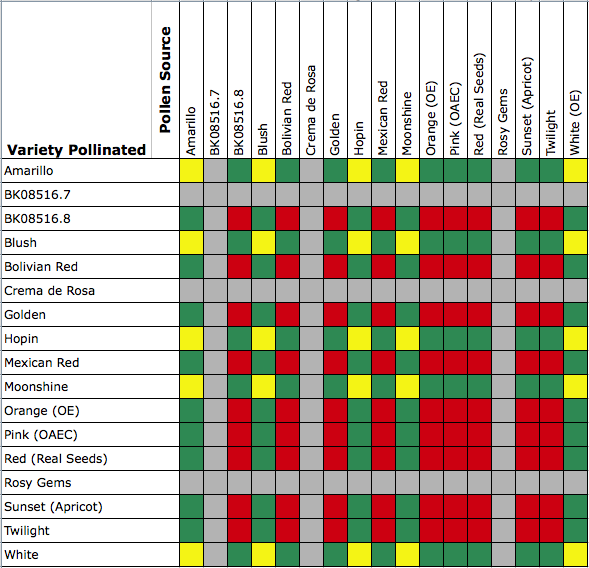Blog, breeding, oca (Oxalis tuberosa)
Oca: Cross pollination chart
Here is an early effort at a crossing chart for varieties of oca (Oxalis tuberosa) available in the US. It still needs a few varieties to be filled in, but it doesn’t seem likely that I’m going to get them to flower this year. I’ll eventually update the chart when I learn the flower types for those varieties. This chart is based entirely on flower type, so there is nothing here that you can’t figure out on your own, but it may save you some time if you’re shopping for compatible varieties.
Gray boxes are unknown (I haven’t observed flowers on those varieties yet). Red boxes offer only illegitimate pollinations that have a very low probability of success (< 1% and a low number of seeds per pod). Green boxes offer legitimate crosses with the highest probability of success (> 70% and a high number of seeds per pod) when the correct levels are used. Yellow boxes offer illegitimate pollinations, but may carry a higher probability of success (< 35% and a low number of seeds per pod) than other illegitimate pollinations. (The stated probabilities are all assumptions based on the kind of cross being performed, not based on actual observations of these crosses with the specific varieties.)
For a lot more detail about oca compatibility, see this post.
This chart doesn’t currently consider the timing of flowering, so it is possible to have compatible flower types that are not ready at the same time. Since there appear to be early and late flowering varieties, I will try to work that in once I have established the flowering periods.
By the way, my reason for focusing on US varieties is not out of some nationalistic preference. Strangely, most suppliers in the US provide named varieties, while most in the UK and Europe do not. We probably have many of the same varieties, but without names to match them up, the best that you can do is make guesses based on the appearance of tuber, plant, and flower and relatively little of that information is available. I continue to be perplexed that so little varietal information is available from New Zealand, where oca is a popular crop. Perhaps someone will take on the task of cataloging the varieties in those countries so that we can work out the matches and more readily share information about them.
Maybe we need an international oca naming (or renaming) project.
Oca seeds and tubers are sometimes available in our seed shop.

